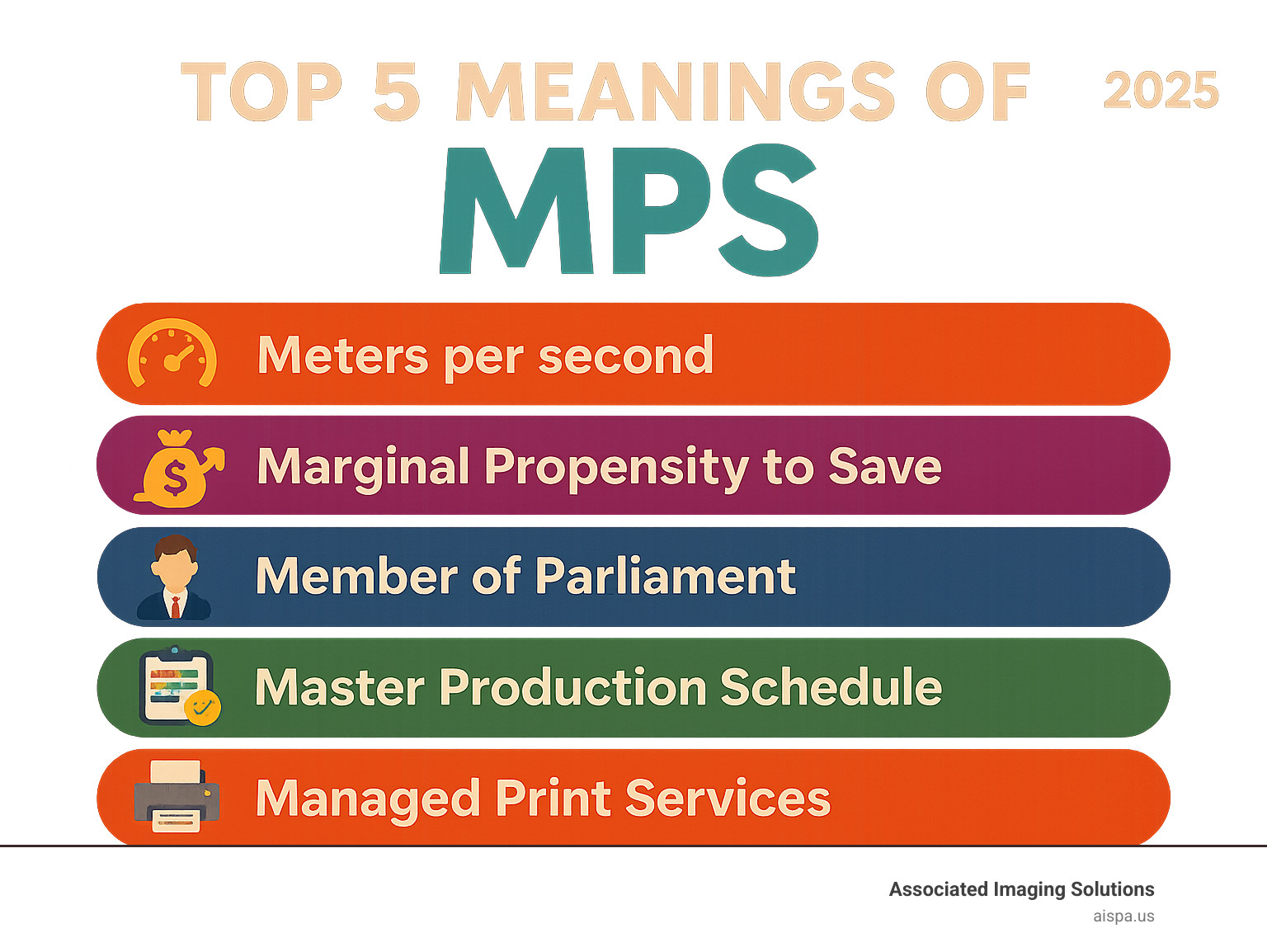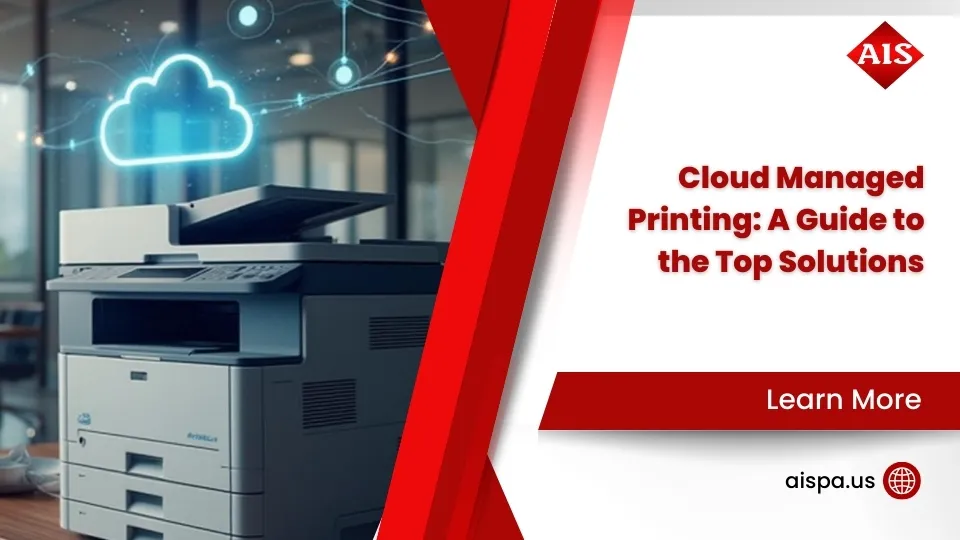Understanding MPS: From Degrees to Printing Services
When you hear define mps, you might be wondering which of its many meanings applies. This common abbreviation can refer to very different things, from units of speed to economic theories and even elected officials. The specific context is key to understanding what MPS means.
Here are some of the most common meanings of ‘MPS’:
- Meters per second (mps): A unit used to measure speed or velocity.
- Marginal Propensity to Save (MPS): In economics, this term describes the proportion of an increase in income that a consumer saves rather than spends.
- Member of Parliament (MP/MPS): An elected representative in a parliamentary system, like in Canada or the UK.
- Master Production Schedule (MPS): A business plan in manufacturing that details what products will be produced, how much, and when.
- Managed Print Services (MPS): A comprehensive business solution that optimizes and manages an organization’s printing environment.
- Metropolitan Police Service (MPS): The territorial police force responsible for law enforcement in Greater London, UK.
Understanding these different meanings helps clarify conversations and information across various fields. Let’s dive deeper into each.

Define mps glossary:
What Does MPS Mean in Business and Economics?
When we dig into business and economics, the abbreviation MPS takes on significant meanings, influencing decisions from personal finance to large-scale manufacturing. These terms are crucial for understanding how economies function and how businesses plan their operations.

How to Define MPS in Economics: Marginal Propensity to Save
In the field of economics, MPS stands for Marginal Propensity to Save. This is a fundamental concept in Keynesian economics theory that helps us understand consumer behavior. Essentially, it refers to the proportion of any additional income that a consumer chooses to save rather than spend on goods and services. Imagine receiving an unexpected bonus; your MPS would be the fraction of that bonus you decide to put into your savings account.
Calculating MPS is straightforward: we divide the change in savings by the change in income. For example, if your income increases by $500 and you decide to save $100 of that increase, your MPS would be 0.2 ($100 saved / $500 income). This tells economists how much of an income increase “leaks” out of the spending stream into savings.
MPS isn’t a fixed number for everyone; it can vary based on income levels. Generally, individuals with higher incomes tend to have a higher MPS, meaning they save a larger proportion of any additional earnings. This concept is vital for governments and policymakers when they consider how spending and investment might impact the economy. It helps them predict how much money will be saved versus spent, influencing economic stimulus measures. You can learn more about the concept of saving and its economic implications by exploring the broader idea of Propensity to Save.
The Relationship Between MPS and MPC
The Marginal Propensity to Save (MPS) is closely intertwined with another key economic concept: the Marginal Propensity to Consume (MPC). While MPS measures the proportion of additional income saved, MPC measures the proportion of additional income spent on consumption. These two concepts are complementary, meaning that when added together, they should always equal one.
Think of it this way: for every extra dollar you earn, you either save it or you spend it. There are no other options! So, if your MPS is 0.2 (meaning you save 20 cents of every new dollar), then your MPC must be 0.8 (meaning you spend 80 cents of every new dollar). Using our previous example, if you saved $100 and spent $400 from your $500 income increase, your MPC would be 0.8 ($400 spent / $500 income).
This relationship is crucial for understanding the Keynesian multiplier, which describes how an initial change in spending or investment can lead to a larger change in overall economic output. The multiplier is calculated as 1 divided by the MPS (1/MPS). A lower MPS means a higher MPC, which in turn leads to a larger economic multiplier effect. This is why economists pay close attention to these propensities when analyzing economic policies.
MPS in Production and Operations
Moving from the theoretical world of economics to the practicalities of business operations, MPS takes on a completely different meaning: Master Production Schedule. This is a critical component of production management, especially in manufacturing. The Master Production Schedule is essentially a plan that details what products will be produced, how much of each, and exactly when they will be available.
It’s not just a wish list; the MPS is a highly detailed, time-phased plan for specific products, often based on a company’s overall business plan and sales forecasts. It considers all the necessary resources required for production, including materials, money, and the time needed for various processes.
The purpose of an MPS is to ensure that production aligns with demand, optimizing inventory levels and resource allocation. It helps businesses avoid both overproduction (which ties up capital) and underproduction (which leads to missed sales opportunities). By providing a clear roadmap for production, the Master Production Schedule helps manufacturing operations run smoothly and efficiently, ensuring that products are ready when customers need them.
How to Define MPS in Government and Politics
When you define MPS in the political world, you’re likely talking about Members of Parliament – the elected representatives who form the backbone of democratic systems around the globe. These dedicated public servants bridge the gap between everyday citizens and national government, making democracy work at the grassroots level.

The Role of a Member of Parliament (MP)
A Member of Parliament in Canada is essentially your voice in Ottawa. These elected officials represent specific geographic areas called constituencies or ridings, carrying the hopes, concerns, and needs of their communities to the nation’s capital. Since 1867, MPs have been the cornerstone of Canadian democracy, working tirelessly to serve both their local communities and the country as a whole.
The life of an MP is surprisingly diverse and demanding. In the Chamber, they’re debating important national issues, voting on new laws, and keeping the government honest during Question Period. You’ll see them introducing bills, making passionate speeches, and presenting reports that could shape Canada’s future.
But the real work often happens behind the scenes in committee rooms. Here, MPs roll up their sleeves to examine proposed laws in detail. They bring in experts, listen to public input, and suggest improvements that can make legislation work better for everyone. It’s like being part detective, part policy expert, and part community advocate all at once.
Perhaps most importantly, MPs spend significant time in their constituencies – your neighborhood. They maintain local offices where you can walk in with concerns about everything from immigration issues to employment insurance problems. They attend community events, town halls, and local celebrations, staying connected to the people who elected them.
In caucus meetings, MPs from the same political party gather to discuss strategy and share what they’re hearing from folks back home. It’s where local concerns become national conversations. Some MPs also serve in Cabinet if the Prime Minister appoints them as Ministers, giving them the chance to run specific government departments.
Each MP earns their position through elections using the first-past-the-post system, typically every four years. As of 2024, Canadian MPs receive an annual salary of CA$203,100 – reflecting the significant responsibility they carry for representing roughly 110,000 fellow Canadians.
How the Number of MPs Changes
The number of MPs isn’t set in stone – it grows and shifts as Canada itself changes. Every ten years, after the national census, the country goes through electoral redistribution. Think of it as rebalancing the scales of democracy to make sure every Canadian’s vote carries equal weight, no matter where they live.
This process has led to steady growth over the years. When Canada first became a nation in 1867, there were just 181 MPs trying to represent the entire country. Following the 2022 redistribution, that number jumped to 343 – a reflection of Canada’s growing population and evolving demographics.
The math is straightforward but important: more people means more representatives. The goal is ensuring that whether you live in a busy city or a rural community, your voice reaches Parliament with the same strength as everyone else’s. Census data drives these changes, helping officials understand where Canadians are living and how representation should be adjusted.
You can dive deeper into this fascinating process through the Redistribution of Federal Electoral Districts | The Canadian Encyclopedia, which explains how these democratic adjustments keep our system fair and representative for all Canadians.
What is Managed Print Services (MPS)?
When you define Mps in the business world, one of the most practical meanings is Managed Print Services. This comprehensive business solution goes far beyond just having printers in your office. It’s about taking complete control of your printing environment to boost efficiency, cut costs, and improve security.

Think of Managed Print Services as having a dedicated team that handles everything related to your printing needs. From the moment you decide you need a document printed until it’s safely in your hands, MPS covers every step of that journey. This includes managing your devices, ensuring you never run out of supplies, and keeping your sensitive documents secure.
For businesses across Pennsylvania, MPS represents a shift from reactive printing management to a proactive, strategic approach. Instead of dealing with broken printers, empty toner cartridges, and unpredictable costs, you get a streamlined system that just works. If you’re wondering about the versatile devices that power modern offices, check out What is an MFP Printer? to understand how multifunction printers fit into the bigger picture.
The Core Components of an MPS Program
Every effective Managed Print Services program starts with understanding your unique needs. At Associated Imaging Solutions, we’ve learned that no two businesses print the same way, which is why our approach begins with a thorough assessment of your current situation. We examine your existing printers, analyze your printing patterns, and identify where money and time are being wasted.
Once we understand your printing landscape, we move to optimization. This means designing a custom strategy that might involve replacing energy-hungry old printers with efficient new models, consolidating multiple devices into strategic locations, or reconfiguring your network for better performance. The goal is simple: get the right equipment in the right places to serve your team effectively.
Proactive management is where MPS really shines. Rather than waiting for printers to break down or run out of supplies, we monitor your devices continuously. This remote monitoring helps us spot potential problems before they disrupt your workday. When a printer starts showing signs of trouble, we’re already working on a solution.
Supply automation eliminates one of the most frustrating aspects of office printing. You’ll never again face that Monday morning surprise of an empty toner cartridge with no replacement in sight. Our systems track your usage and automatically ship supplies when you need them, ensuring smooth operations.
Security has become increasingly critical as businesses handle more sensitive information. MPS programs include robust security features like secure print release, user authentication, and data encryption. These protections ensure your confidential documents don’t end up in the wrong hands.
The final component is comprehensive support and maintenance. Our Philadelphia-based team provides quick response times when you need help, keeping your printing infrastructure running smoothly. This local expertise combined with advanced technology ensures minimal downtime for your business.
Selecting the right partner for your print management can make all the difference. Our guide on Choosing the Right Print Management Company offers valuable insights into what to look for in a provider.
Benefits of Implementing MPS for Your Business
The most compelling reason businesses choose Managed Print Services is the significant cost savings. MPS transforms unpredictable printing expenses into manageable, budgeted costs. You’ll see reductions in device maintenance, supply procurement, and energy consumption. Our Copier Lease options also eliminate large upfront equipment purchases, making high-quality technology accessible to businesses of all sizes.
Improved productivity naturally follows when your printing infrastructure works reliably. Your employees spend less time troubleshooting printer problems and more time focusing on their core responsibilities. Optimized workflows mean documents print faster, and automated supply deliveries prevent work interruptions.
Improved document security has become essential for protecting sensitive business information. MPS provides multiple layers of security, from user authentication to data encryption. These features help you comply with industry regulations while keeping confidential information safe from unauthorized access.
Environmental sustainability benefits both your budget and your community. By optimizing device usage, reducing paper waste, and implementing responsible recycling programs, MPS helps your business minimize its environmental impact. Many of our clients find this aligns perfectly with their corporate sustainability goals.
Predictable budgeting replaces the chaos of fluctuating printing costs with stable, manageable expenses. Instead of surprise repair bills or emergency supply purchases, you’ll have a clear understanding of your monthly printing costs. This predictability makes financial planning much easier and more accurate.
These benefits work together to create a printing environment that truly supports your business goals rather than creating obstacles to overcome.
Other Common Meanings for the Abbreviation MPS
As we’ve seen, define mps can lead you down many different paths depending on your field of interest. This versatile acronym adapts to fit countless contexts, from precise scientific measurements to academic achievements and law enforcement agencies.
Let’s explore how MPS shows up across various industries and disciplines:
| Field | Meaning of MPS | Description |
|---|---|---|
| Science | Meters per second (m/s) | A fundamental unit for measuring speed and velocity in physics |
| Technology | Megapixels or Multiprocessing Specification | Digital camera resolution or computer processing standards |
| Education | Master of Professional Studies | An advanced graduate degree focusing on practical, career-oriented skills |
| Law Enforcement | Metropolitan Police Service | The primary police force serving Greater London, United Kingdom |
MPS in Science and Technology
In the scientific world, MPS most commonly appears as meters per second (often written as m/s), which measures how fast something moves. Whether you’re calculating the speed of a car, the velocity of a falling object, or the flow rate of water through a pipe, this unit helps scientists and engineers quantify motion with precision.
The technology sector also accepts MPS in different ways. Megapixels determine the resolution quality of digital cameras and displays, telling you how sharp and detailed your photos will be. Meanwhile, Multiprocessing Specification refers to technical standards that help computer systems handle multiple tasks simultaneously, making your devices run more efficiently.
These scientific and technical meanings of MPS highlight how acronyms often serve as shorthand for complex concepts, making professional communication faster and more precise.
MPS in Education and Law Enforcement
Higher education uses MPS to represent the Master of Professional Studies, a graduate degree that bridges academic learning with real-world application. Unlike traditional research-focused master’s programs, an MPS degree emphasizes practical skills and professional development, preparing students for immediate career advancement in their chosen fields.
Across the Atlantic, the Metropolitan Police Service serves as London’s primary law enforcement agency. This MPS has been protecting Greater London since 1829, making it one of the world’s oldest and most recognizable police forces. With over 30,000 officers, they handle everything from routine patrols to complex criminal investigations throughout the busy metropolis.
These diverse meanings show how context shapes understanding. Whether you’re discussing academic credentials or public safety, the same three letters carry completely different significance based on the conversation you’re having.











